Examining the Cause of High Staff Turnover at Grand Mercure Hotel
VerifiedAdded on 2023/06/04
|8
|2369
|314
AI Summary
This report examines the cause of high staff turnover at Grand Mercure Hotel due to lower wage, low job satisfaction level and inter-clash conflicts among others. The report recommends implementing the conjunctive selection strategy, providing adequate compensation, scope for development and growth, paying proper attention to employee’s physical as well as mental wellness, and scheduling adequate training and development programs to enhance the skill of employees.
Contribute Materials
Your contribution can guide someone’s learning journey. Share your
documents today.
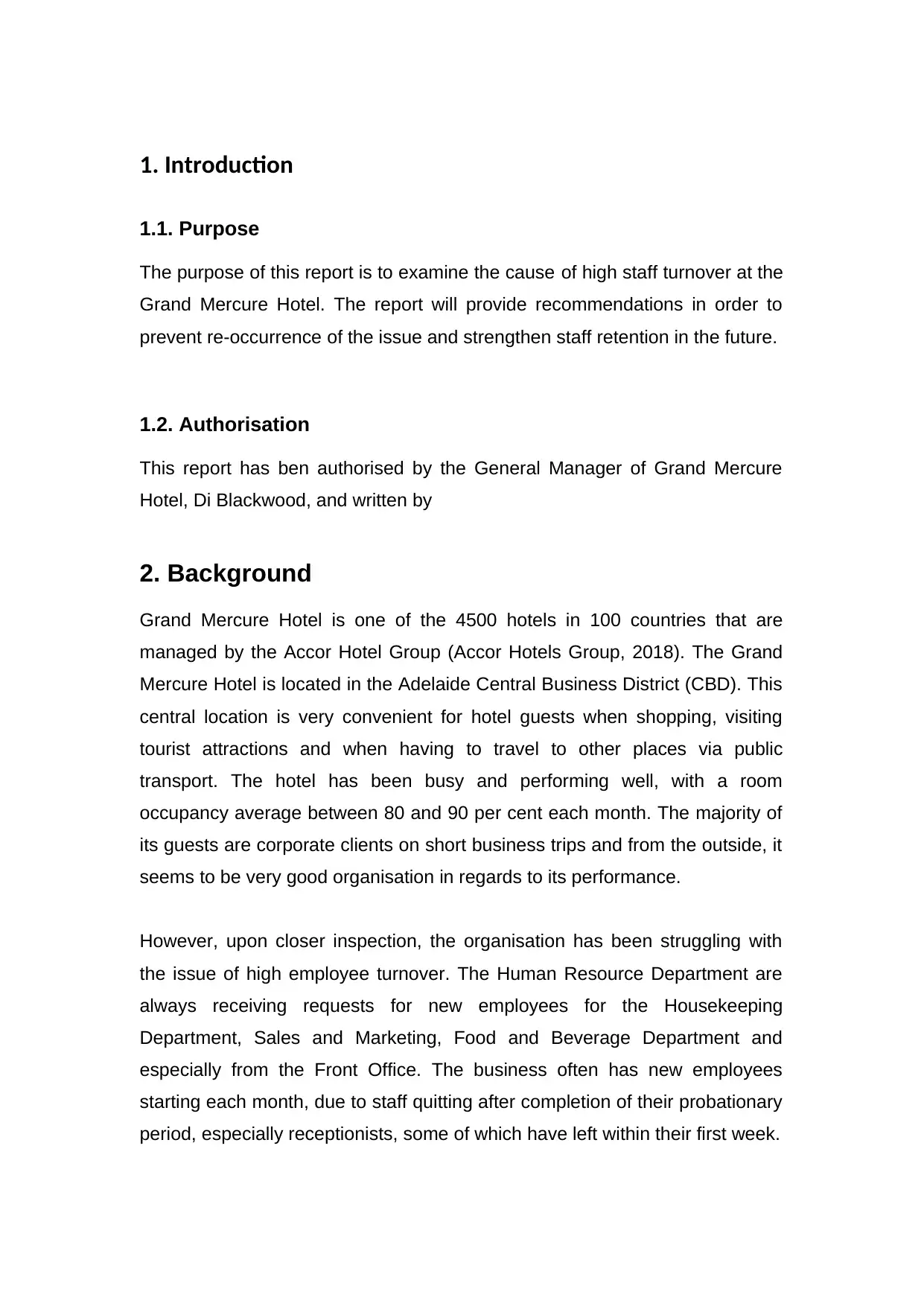
1. Introduction
1.1. Purpose
The purpose of this report is to examine the cause of high staff turnover at the
Grand Mercure Hotel. The report will provide recommendations in order to
prevent re-occurrence of the issue and strengthen staff retention in the future.
1.2. Authorisation
This report has ben authorised by the General Manager of Grand Mercure
Hotel, Di Blackwood, and written by
2. Background
Grand Mercure Hotel is one of the 4500 hotels in 100 countries that are
managed by the Accor Hotel Group (Accor Hotels Group, 2018). The Grand
Mercure Hotel is located in the Adelaide Central Business District (CBD). This
central location is very convenient for hotel guests when shopping, visiting
tourist attractions and when having to travel to other places via public
transport. The hotel has been busy and performing well, with a room
occupancy average between 80 and 90 per cent each month. The majority of
its guests are corporate clients on short business trips and from the outside, it
seems to be very good organisation in regards to its performance.
However, upon closer inspection, the organisation has been struggling with
the issue of high employee turnover. The Human Resource Department are
always receiving requests for new employees for the Housekeeping
Department, Sales and Marketing, Food and Beverage Department and
especially from the Front Office. The business often has new employees
starting each month, due to staff quitting after completion of their probationary
period, especially receptionists, some of which have left within their first week.
1.1. Purpose
The purpose of this report is to examine the cause of high staff turnover at the
Grand Mercure Hotel. The report will provide recommendations in order to
prevent re-occurrence of the issue and strengthen staff retention in the future.
1.2. Authorisation
This report has ben authorised by the General Manager of Grand Mercure
Hotel, Di Blackwood, and written by
2. Background
Grand Mercure Hotel is one of the 4500 hotels in 100 countries that are
managed by the Accor Hotel Group (Accor Hotels Group, 2018). The Grand
Mercure Hotel is located in the Adelaide Central Business District (CBD). This
central location is very convenient for hotel guests when shopping, visiting
tourist attractions and when having to travel to other places via public
transport. The hotel has been busy and performing well, with a room
occupancy average between 80 and 90 per cent each month. The majority of
its guests are corporate clients on short business trips and from the outside, it
seems to be very good organisation in regards to its performance.
However, upon closer inspection, the organisation has been struggling with
the issue of high employee turnover. The Human Resource Department are
always receiving requests for new employees for the Housekeeping
Department, Sales and Marketing, Food and Beverage Department and
especially from the Front Office. The business often has new employees
starting each month, due to staff quitting after completion of their probationary
period, especially receptionists, some of which have left within their first week.
Secure Best Marks with AI Grader
Need help grading? Try our AI Grader for instant feedback on your assignments.
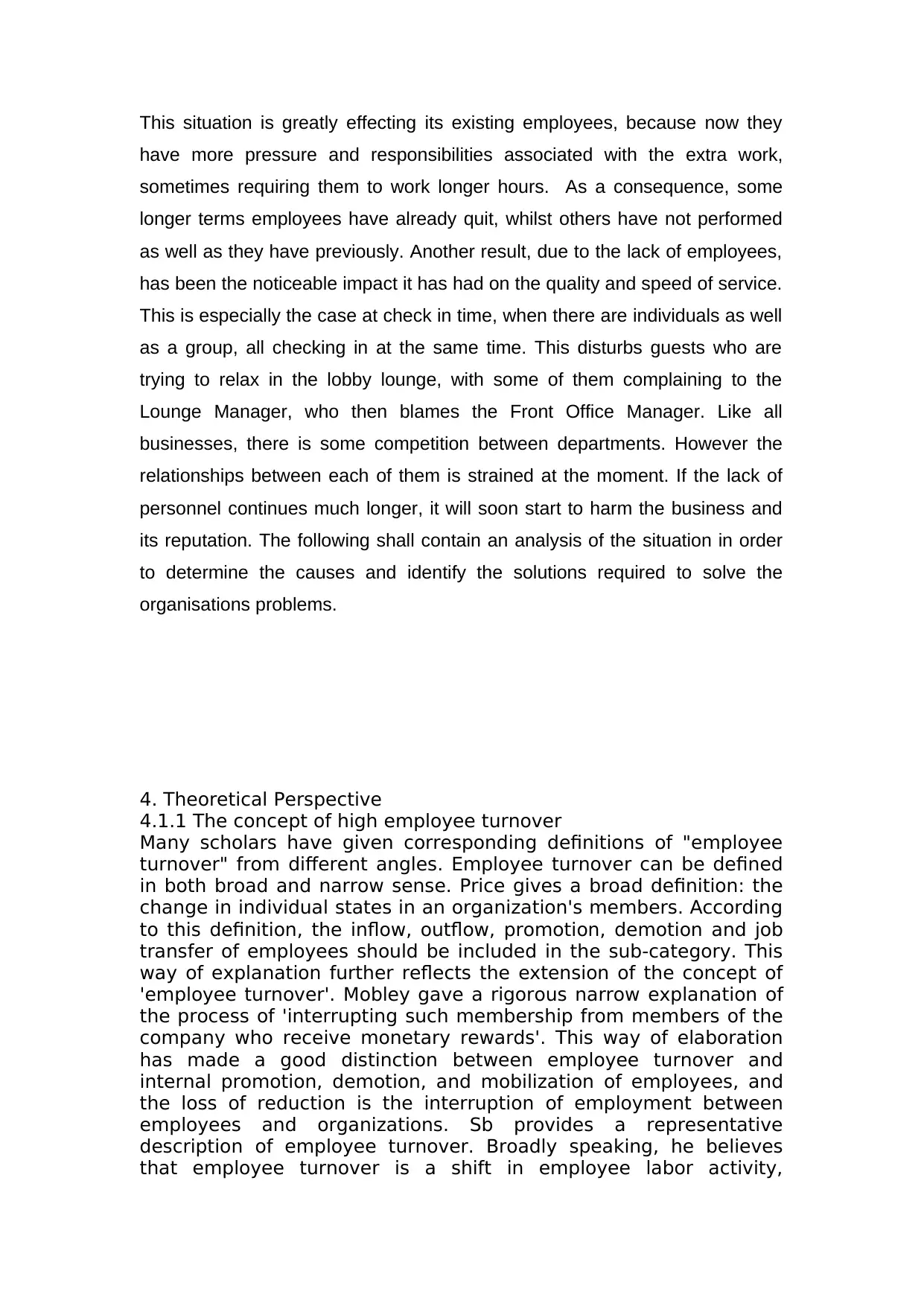
This situation is greatly effecting its existing employees, because now they
have more pressure and responsibilities associated with the extra work,
sometimes requiring them to work longer hours. As a consequence, some
longer terms employees have already quit, whilst others have not performed
as well as they have previously. Another result, due to the lack of employees,
has been the noticeable impact it has had on the quality and speed of service.
This is especially the case at check in time, when there are individuals as well
as a group, all checking in at the same time. This disturbs guests who are
trying to relax in the lobby lounge, with some of them complaining to the
Lounge Manager, who then blames the Front Office Manager. Like all
businesses, there is some competition between departments. However the
relationships between each of them is strained at the moment. If the lack of
personnel continues much longer, it will soon start to harm the business and
its reputation. The following shall contain an analysis of the situation in order
to determine the causes and identify the solutions required to solve the
organisations problems.
4. Theoretical Perspective
4.1.1 The concept of high employee turnover
Many scholars have given corresponding definitions of "employee
turnover" from different angles. Employee turnover can be defined
in both broad and narrow sense. Price gives a broad definition: the
change in individual states in an organization's members. According
to this definition, the inflow, outflow, promotion, demotion and job
transfer of employees should be included in the sub-category. This
way of explanation further reflects the extension of the concept of
'employee turnover'. Mobley gave a rigorous narrow explanation of
the process of 'interrupting such membership from members of the
company who receive monetary rewards'. This way of elaboration
has made a good distinction between employee turnover and
internal promotion, demotion, and mobilization of employees, and
the loss of reduction is the interruption of employment between
employees and organizations. Sb provides a representative
description of employee turnover. Broadly speaking, he believes
that employee turnover is a shift in employee labor activity,
have more pressure and responsibilities associated with the extra work,
sometimes requiring them to work longer hours. As a consequence, some
longer terms employees have already quit, whilst others have not performed
as well as they have previously. Another result, due to the lack of employees,
has been the noticeable impact it has had on the quality and speed of service.
This is especially the case at check in time, when there are individuals as well
as a group, all checking in at the same time. This disturbs guests who are
trying to relax in the lobby lounge, with some of them complaining to the
Lounge Manager, who then blames the Front Office Manager. Like all
businesses, there is some competition between departments. However the
relationships between each of them is strained at the moment. If the lack of
personnel continues much longer, it will soon start to harm the business and
its reputation. The following shall contain an analysis of the situation in order
to determine the causes and identify the solutions required to solve the
organisations problems.
4. Theoretical Perspective
4.1.1 The concept of high employee turnover
Many scholars have given corresponding definitions of "employee
turnover" from different angles. Employee turnover can be defined
in both broad and narrow sense. Price gives a broad definition: the
change in individual states in an organization's members. According
to this definition, the inflow, outflow, promotion, demotion and job
transfer of employees should be included in the sub-category. This
way of explanation further reflects the extension of the concept of
'employee turnover'. Mobley gave a rigorous narrow explanation of
the process of 'interrupting such membership from members of the
company who receive monetary rewards'. This way of elaboration
has made a good distinction between employee turnover and
internal promotion, demotion, and mobilization of employees, and
the loss of reduction is the interruption of employment between
employees and organizations. Sb provides a representative
description of employee turnover. Broadly speaking, he believes
that employee turnover is a shift in employee labor activity,
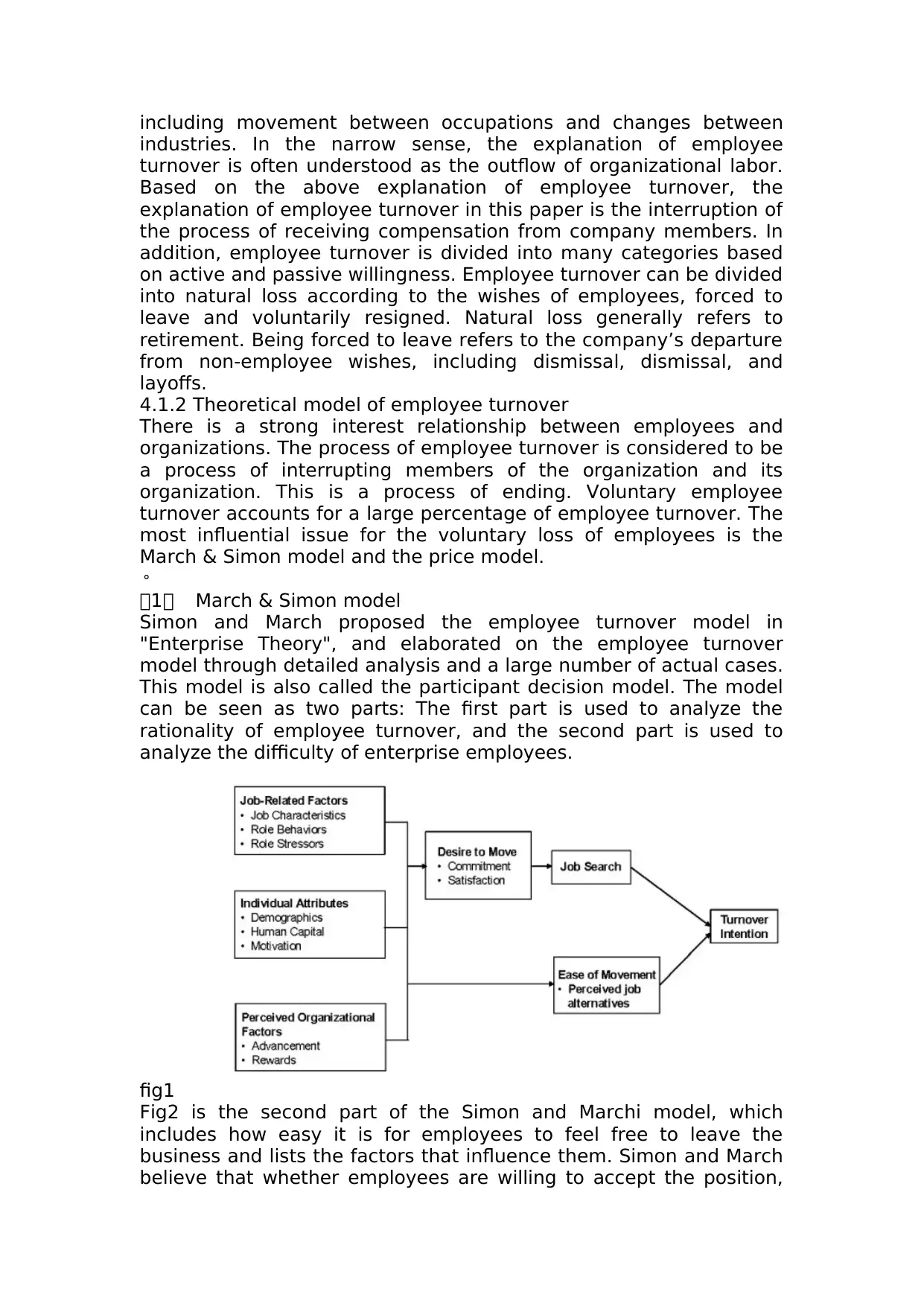
including movement between occupations and changes between
industries. In the narrow sense, the explanation of employee
turnover is often understood as the outflow of organizational labor.
Based on the above explanation of employee turnover, the
explanation of employee turnover in this paper is the interruption of
the process of receiving compensation from company members. In
addition, employee turnover is divided into many categories based
on active and passive willingness. Employee turnover can be divided
into natural loss according to the wishes of employees, forced to
leave and voluntarily resigned. Natural loss generally refers to
retirement. Being forced to leave refers to the company’s departure
from non-employee wishes, including dismissal, dismissal, and
layoffs.
4.1.2 Theoretical model of employee turnover
There is a strong interest relationship between employees and
organizations. The process of employee turnover is considered to be
a process of interrupting members of the organization and its
organization. This is a process of ending. Voluntary employee
turnover accounts for a large percentage of employee turnover. The
most influential issue for the voluntary loss of employees is the
March & Simon model and the price model.
。
(1( March & Simon model
Simon and March proposed the employee turnover model in
"Enterprise Theory", and elaborated on the employee turnover
model through detailed analysis and a large number of actual cases.
This model is also called the participant decision model. The model
can be seen as two parts: The first part is used to analyze the
rationality of employee turnover, and the second part is used to
analyze the difficulty of enterprise employees.
fig1
Fig2 is the second part of the Simon and Marchi model, which
includes how easy it is for employees to feel free to leave the
business and lists the factors that influence them. Simon and March
believe that whether employees are willing to accept the position,
industries. In the narrow sense, the explanation of employee
turnover is often understood as the outflow of organizational labor.
Based on the above explanation of employee turnover, the
explanation of employee turnover in this paper is the interruption of
the process of receiving compensation from company members. In
addition, employee turnover is divided into many categories based
on active and passive willingness. Employee turnover can be divided
into natural loss according to the wishes of employees, forced to
leave and voluntarily resigned. Natural loss generally refers to
retirement. Being forced to leave refers to the company’s departure
from non-employee wishes, including dismissal, dismissal, and
layoffs.
4.1.2 Theoretical model of employee turnover
There is a strong interest relationship between employees and
organizations. The process of employee turnover is considered to be
a process of interrupting members of the organization and its
organization. This is a process of ending. Voluntary employee
turnover accounts for a large percentage of employee turnover. The
most influential issue for the voluntary loss of employees is the
March & Simon model and the price model.
。
(1( March & Simon model
Simon and March proposed the employee turnover model in
"Enterprise Theory", and elaborated on the employee turnover
model through detailed analysis and a large number of actual cases.
This model is also called the participant decision model. The model
can be seen as two parts: The first part is used to analyze the
rationality of employee turnover, and the second part is used to
analyze the difficulty of enterprise employees.
fig1
Fig2 is the second part of the Simon and Marchi model, which
includes how easy it is for employees to feel free to leave the
business and lists the factors that influence them. Simon and March
believe that whether employees are willing to accept the position,

the ability of employees to be qualified for positions, and the
number of companies available for selection are three important
factors in determining employee turnover.
Fig2
(2( Price model
In response to the mobility problem of employees, the American
scholar price proposed the famous Price model (fig 3). The main
research field of price is the brain drain problem. The model
proposed by him involves the brain drain determinant and the brain
drain model of the disturbance variable.
Among them, many of the main factors determining employee
turnover are raised in her research, including employee
compensation levels, employee engagement, communication
between employees, and the level of corporate democratic
centralization. The first three factors affect the employee's flow is a
positive relationship, and the last factor is a negative relationship to
the employee's flow. In particular, it is worth mentioning that in this
number of companies available for selection are three important
factors in determining employee turnover.
Fig2
(2( Price model
In response to the mobility problem of employees, the American
scholar price proposed the famous Price model (fig 3). The main
research field of price is the brain drain problem. The model
proposed by him involves the brain drain determinant and the brain
drain model of the disturbance variable.
Among them, many of the main factors determining employee
turnover are raised in her research, including employee
compensation levels, employee engagement, communication
between employees, and the level of corporate democratic
centralization. The first three factors affect the employee's flow is a
positive relationship, and the last factor is a negative relationship to
the employee's flow. In particular, it is worth mentioning that in this
Paraphrase This Document
Need a fresh take? Get an instant paraphrase of this document with our AI Paraphraser
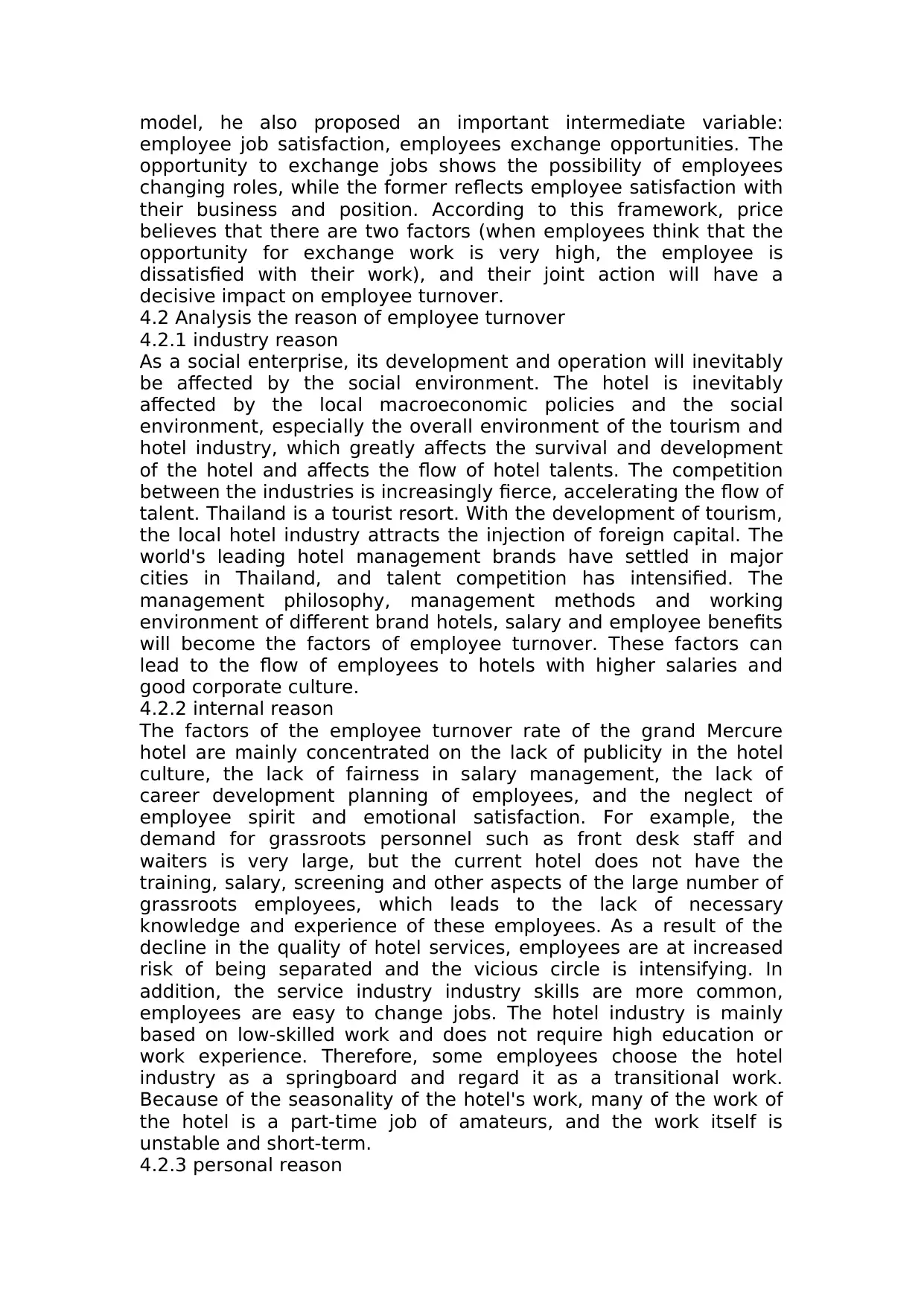
model, he also proposed an important intermediate variable:
employee job satisfaction, employees exchange opportunities. The
opportunity to exchange jobs shows the possibility of employees
changing roles, while the former reflects employee satisfaction with
their business and position. According to this framework, price
believes that there are two factors (when employees think that the
opportunity for exchange work is very high, the employee is
dissatisfied with their work), and their joint action will have a
decisive impact on employee turnover.
4.2 Analysis the reason of employee turnover
4.2.1 industry reason
As a social enterprise, its development and operation will inevitably
be affected by the social environment. The hotel is inevitably
affected by the local macroeconomic policies and the social
environment, especially the overall environment of the tourism and
hotel industry, which greatly affects the survival and development
of the hotel and affects the flow of hotel talents. The competition
between the industries is increasingly fierce, accelerating the flow of
talent. Thailand is a tourist resort. With the development of tourism,
the local hotel industry attracts the injection of foreign capital. The
world's leading hotel management brands have settled in major
cities in Thailand, and talent competition has intensified. The
management philosophy, management methods and working
environment of different brand hotels, salary and employee benefits
will become the factors of employee turnover. These factors can
lead to the flow of employees to hotels with higher salaries and
good corporate culture.
4.2.2 internal reason
The factors of the employee turnover rate of the grand Mercure
hotel are mainly concentrated on the lack of publicity in the hotel
culture, the lack of fairness in salary management, the lack of
career development planning of employees, and the neglect of
employee spirit and emotional satisfaction. For example, the
demand for grassroots personnel such as front desk staff and
waiters is very large, but the current hotel does not have the
training, salary, screening and other aspects of the large number of
grassroots employees, which leads to the lack of necessary
knowledge and experience of these employees. As a result of the
decline in the quality of hotel services, employees are at increased
risk of being separated and the vicious circle is intensifying. In
addition, the service industry industry skills are more common,
employees are easy to change jobs. The hotel industry is mainly
based on low-skilled work and does not require high education or
work experience. Therefore, some employees choose the hotel
industry as a springboard and regard it as a transitional work.
Because of the seasonality of the hotel's work, many of the work of
the hotel is a part-time job of amateurs, and the work itself is
unstable and short-term.
4.2.3 personal reason
employee job satisfaction, employees exchange opportunities. The
opportunity to exchange jobs shows the possibility of employees
changing roles, while the former reflects employee satisfaction with
their business and position. According to this framework, price
believes that there are two factors (when employees think that the
opportunity for exchange work is very high, the employee is
dissatisfied with their work), and their joint action will have a
decisive impact on employee turnover.
4.2 Analysis the reason of employee turnover
4.2.1 industry reason
As a social enterprise, its development and operation will inevitably
be affected by the social environment. The hotel is inevitably
affected by the local macroeconomic policies and the social
environment, especially the overall environment of the tourism and
hotel industry, which greatly affects the survival and development
of the hotel and affects the flow of hotel talents. The competition
between the industries is increasingly fierce, accelerating the flow of
talent. Thailand is a tourist resort. With the development of tourism,
the local hotel industry attracts the injection of foreign capital. The
world's leading hotel management brands have settled in major
cities in Thailand, and talent competition has intensified. The
management philosophy, management methods and working
environment of different brand hotels, salary and employee benefits
will become the factors of employee turnover. These factors can
lead to the flow of employees to hotels with higher salaries and
good corporate culture.
4.2.2 internal reason
The factors of the employee turnover rate of the grand Mercure
hotel are mainly concentrated on the lack of publicity in the hotel
culture, the lack of fairness in salary management, the lack of
career development planning of employees, and the neglect of
employee spirit and emotional satisfaction. For example, the
demand for grassroots personnel such as front desk staff and
waiters is very large, but the current hotel does not have the
training, salary, screening and other aspects of the large number of
grassroots employees, which leads to the lack of necessary
knowledge and experience of these employees. As a result of the
decline in the quality of hotel services, employees are at increased
risk of being separated and the vicious circle is intensifying. In
addition, the service industry industry skills are more common,
employees are easy to change jobs. The hotel industry is mainly
based on low-skilled work and does not require high education or
work experience. Therefore, some employees choose the hotel
industry as a springboard and regard it as a transitional work.
Because of the seasonality of the hotel's work, many of the work of
the hotel is a part-time job of amateurs, and the work itself is
unstable and short-term.
4.2.3 personal reason
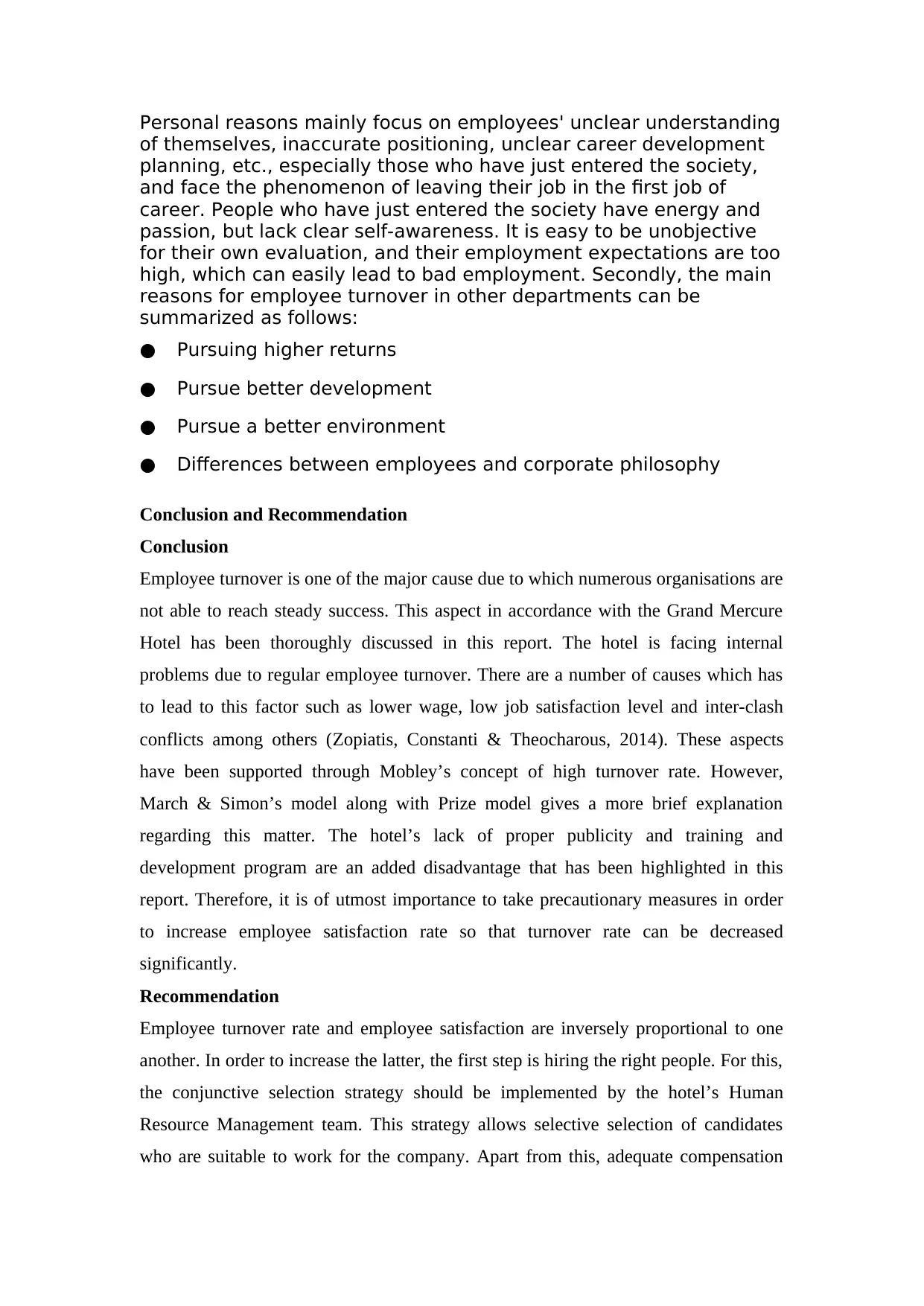
Personal reasons mainly focus on employees' unclear understanding
of themselves, inaccurate positioning, unclear career development
planning, etc., especially those who have just entered the society,
and face the phenomenon of leaving their job in the first job of
career. People who have just entered the society have energy and
passion, but lack clear self-awareness. It is easy to be unobjective
for their own evaluation, and their employment expectations are too
high, which can easily lead to bad employment. Secondly, the main
reasons for employee turnover in other departments can be
summarized as follows:
● Pursuing higher returns
● Pursue better development
● Pursue a better environment
● Differences between employees and corporate philosophy
Conclusion and Recommendation
Conclusion
Employee turnover is one of the major cause due to which numerous organisations are
not able to reach steady success. This aspect in accordance with the Grand Mercure
Hotel has been thoroughly discussed in this report. The hotel is facing internal
problems due to regular employee turnover. There are a number of causes which has
to lead to this factor such as lower wage, low job satisfaction level and inter-clash
conflicts among others (Zopiatis, Constanti & Theocharous, 2014). These aspects
have been supported through Mobley’s concept of high turnover rate. However,
March & Simon’s model along with Prize model gives a more brief explanation
regarding this matter. The hotel’s lack of proper publicity and training and
development program are an added disadvantage that has been highlighted in this
report. Therefore, it is of utmost importance to take precautionary measures in order
to increase employee satisfaction rate so that turnover rate can be decreased
significantly.
Recommendation
Employee turnover rate and employee satisfaction are inversely proportional to one
another. In order to increase the latter, the first step is hiring the right people. For this,
the conjunctive selection strategy should be implemented by the hotel’s Human
Resource Management team. This strategy allows selective selection of candidates
who are suitable to work for the company. Apart from this, adequate compensation
of themselves, inaccurate positioning, unclear career development
planning, etc., especially those who have just entered the society,
and face the phenomenon of leaving their job in the first job of
career. People who have just entered the society have energy and
passion, but lack clear self-awareness. It is easy to be unobjective
for their own evaluation, and their employment expectations are too
high, which can easily lead to bad employment. Secondly, the main
reasons for employee turnover in other departments can be
summarized as follows:
● Pursuing higher returns
● Pursue better development
● Pursue a better environment
● Differences between employees and corporate philosophy
Conclusion and Recommendation
Conclusion
Employee turnover is one of the major cause due to which numerous organisations are
not able to reach steady success. This aspect in accordance with the Grand Mercure
Hotel has been thoroughly discussed in this report. The hotel is facing internal
problems due to regular employee turnover. There are a number of causes which has
to lead to this factor such as lower wage, low job satisfaction level and inter-clash
conflicts among others (Zopiatis, Constanti & Theocharous, 2014). These aspects
have been supported through Mobley’s concept of high turnover rate. However,
March & Simon’s model along with Prize model gives a more brief explanation
regarding this matter. The hotel’s lack of proper publicity and training and
development program are an added disadvantage that has been highlighted in this
report. Therefore, it is of utmost importance to take precautionary measures in order
to increase employee satisfaction rate so that turnover rate can be decreased
significantly.
Recommendation
Employee turnover rate and employee satisfaction are inversely proportional to one
another. In order to increase the latter, the first step is hiring the right people. For this,
the conjunctive selection strategy should be implemented by the hotel’s Human
Resource Management team. This strategy allows selective selection of candidates
who are suitable to work for the company. Apart from this, adequate compensation
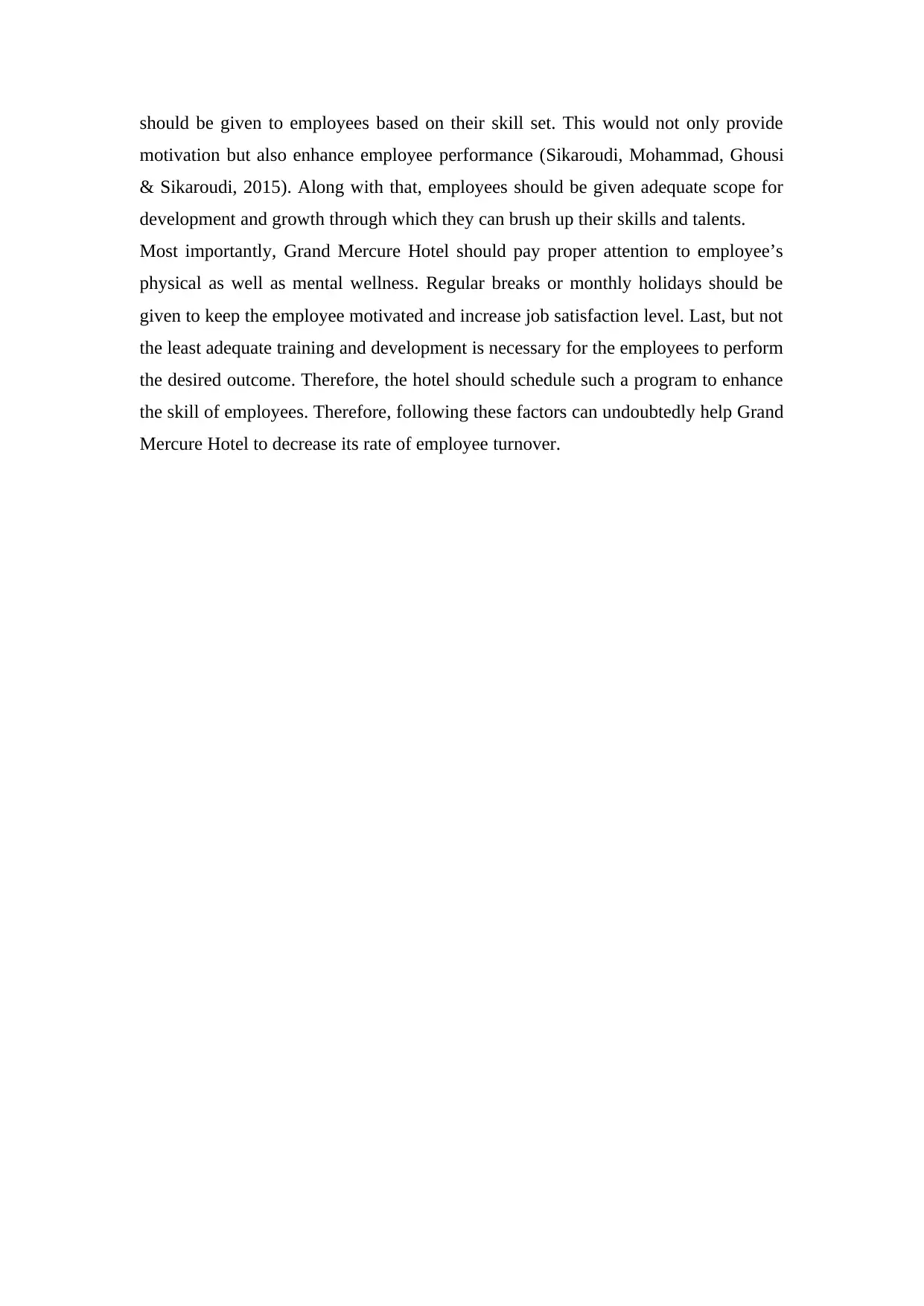
should be given to employees based on their skill set. This would not only provide
motivation but also enhance employee performance (Sikaroudi, Mohammad, Ghousi
& Sikaroudi, 2015). Along with that, employees should be given adequate scope for
development and growth through which they can brush up their skills and talents.
Most importantly, Grand Mercure Hotel should pay proper attention to employee’s
physical as well as mental wellness. Regular breaks or monthly holidays should be
given to keep the employee motivated and increase job satisfaction level. Last, but not
the least adequate training and development is necessary for the employees to perform
the desired outcome. Therefore, the hotel should schedule such a program to enhance
the skill of employees. Therefore, following these factors can undoubtedly help Grand
Mercure Hotel to decrease its rate of employee turnover.
motivation but also enhance employee performance (Sikaroudi, Mohammad, Ghousi
& Sikaroudi, 2015). Along with that, employees should be given adequate scope for
development and growth through which they can brush up their skills and talents.
Most importantly, Grand Mercure Hotel should pay proper attention to employee’s
physical as well as mental wellness. Regular breaks or monthly holidays should be
given to keep the employee motivated and increase job satisfaction level. Last, but not
the least adequate training and development is necessary for the employees to perform
the desired outcome. Therefore, the hotel should schedule such a program to enhance
the skill of employees. Therefore, following these factors can undoubtedly help Grand
Mercure Hotel to decrease its rate of employee turnover.
Secure Best Marks with AI Grader
Need help grading? Try our AI Grader for instant feedback on your assignments.
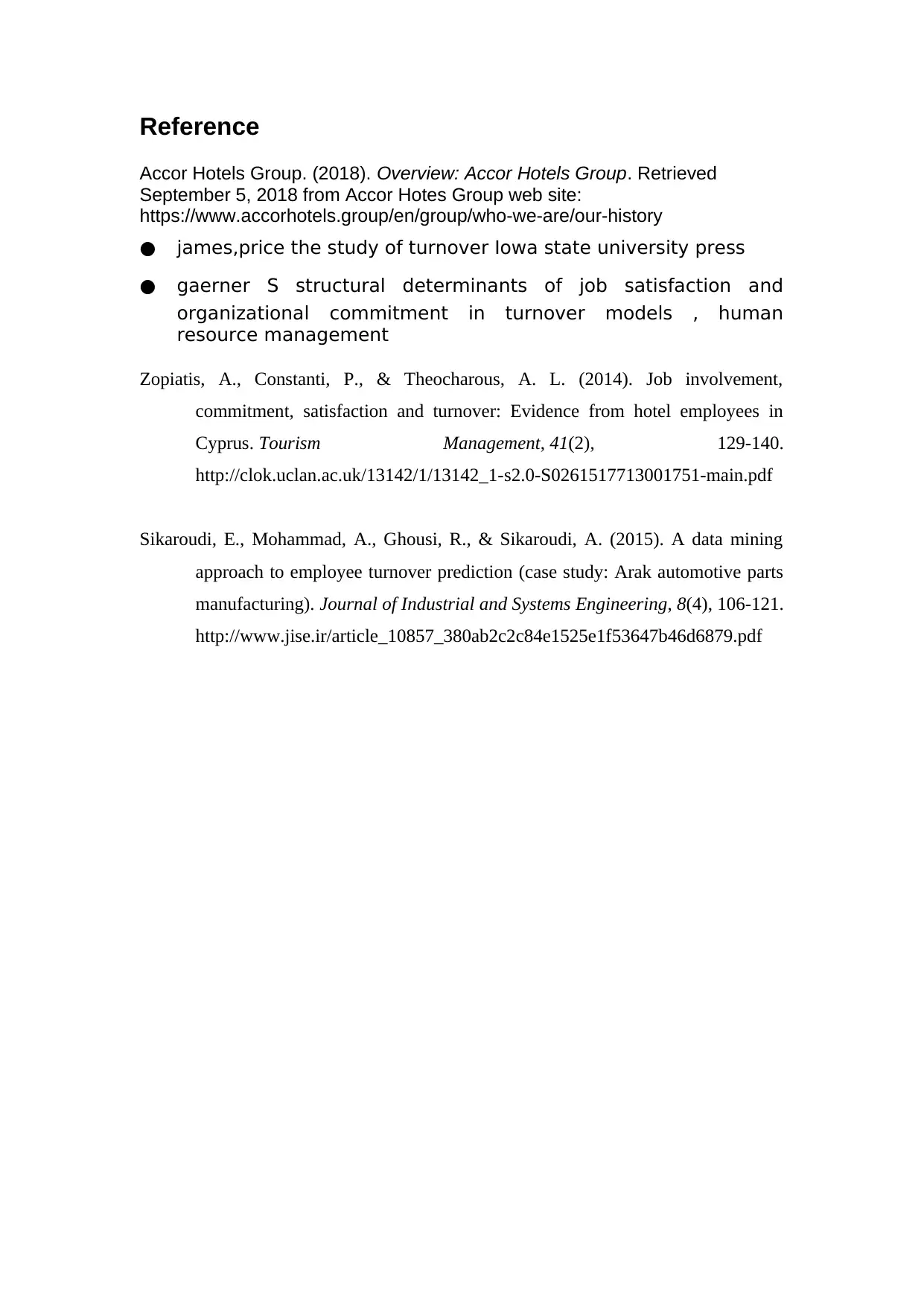
Reference
Accor Hotels Group. (2018). Overview: Accor Hotels Group. Retrieved
September 5, 2018 from Accor Hotes Group web site:
https://www.accorhotels.group/en/group/who-we-are/our-history
● james,price the study of turnover Iowa state university press
● gaerner S structural determinants of job satisfaction and
organizational commitment in turnover models , human
resource management
Zopiatis, A., Constanti, P., & Theocharous, A. L. (2014). Job involvement,
commitment, satisfaction and turnover: Evidence from hotel employees in
Cyprus. Tourism Management, 41(2), 129-140.
http://clok.uclan.ac.uk/13142/1/13142_1-s2.0-S0261517713001751-main.pdf
Sikaroudi, E., Mohammad, A., Ghousi, R., & Sikaroudi, A. (2015). A data mining
approach to employee turnover prediction (case study: Arak automotive parts
manufacturing). Journal of Industrial and Systems Engineering, 8(4), 106-121.
http://www.jise.ir/article_10857_380ab2c2c84e1525e1f53647b46d6879.pdf
Accor Hotels Group. (2018). Overview: Accor Hotels Group. Retrieved
September 5, 2018 from Accor Hotes Group web site:
https://www.accorhotels.group/en/group/who-we-are/our-history
● james,price the study of turnover Iowa state university press
● gaerner S structural determinants of job satisfaction and
organizational commitment in turnover models , human
resource management
Zopiatis, A., Constanti, P., & Theocharous, A. L. (2014). Job involvement,
commitment, satisfaction and turnover: Evidence from hotel employees in
Cyprus. Tourism Management, 41(2), 129-140.
http://clok.uclan.ac.uk/13142/1/13142_1-s2.0-S0261517713001751-main.pdf
Sikaroudi, E., Mohammad, A., Ghousi, R., & Sikaroudi, A. (2015). A data mining
approach to employee turnover prediction (case study: Arak automotive parts
manufacturing). Journal of Industrial and Systems Engineering, 8(4), 106-121.
http://www.jise.ir/article_10857_380ab2c2c84e1525e1f53647b46d6879.pdf
1 out of 8
Related Documents
Your All-in-One AI-Powered Toolkit for Academic Success.
+13062052269
info@desklib.com
Available 24*7 on WhatsApp / Email
![[object Object]](/_next/static/media/star-bottom.7253800d.svg)
Unlock your academic potential
© 2024 | Zucol Services PVT LTD | All rights reserved.





